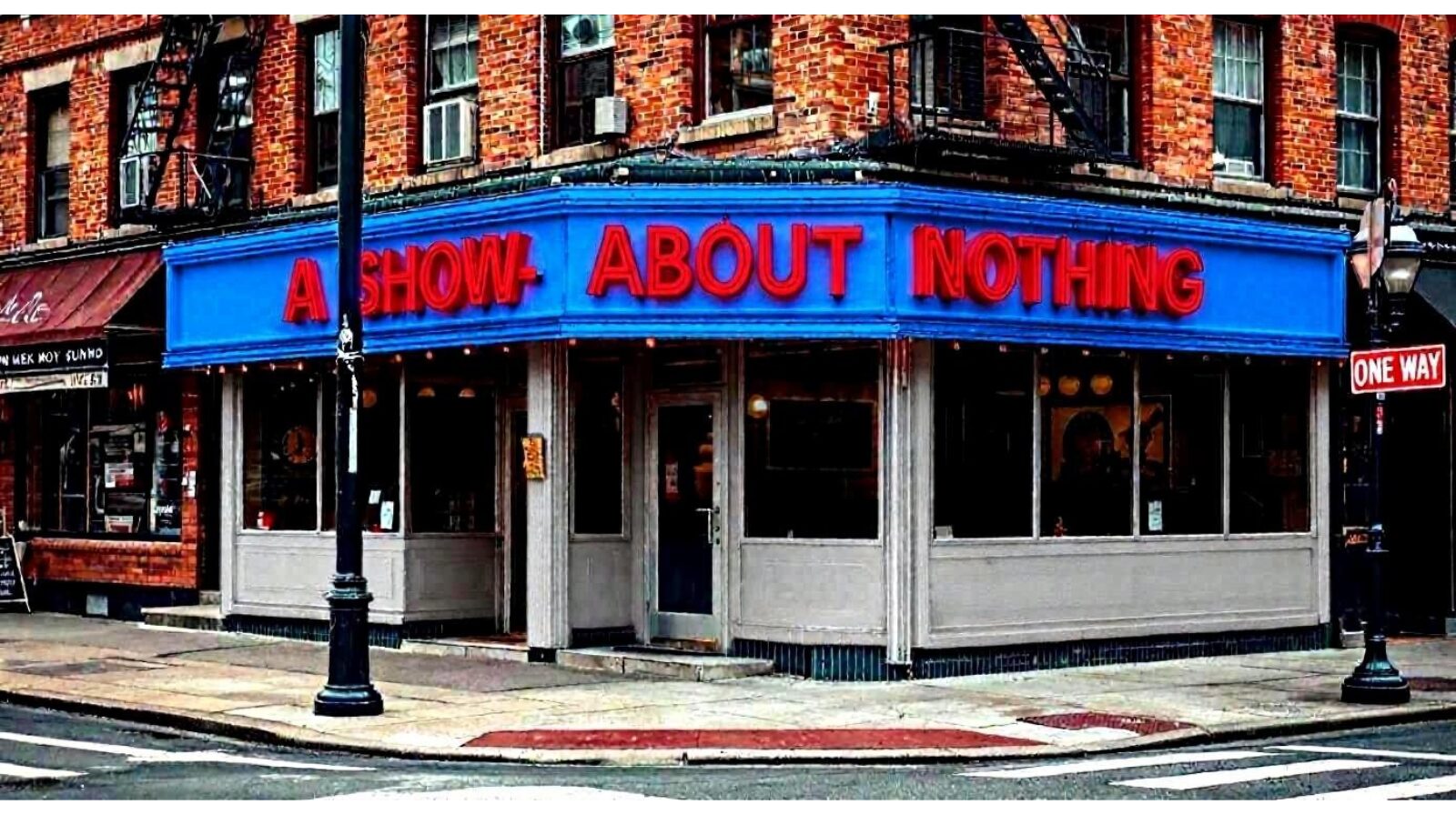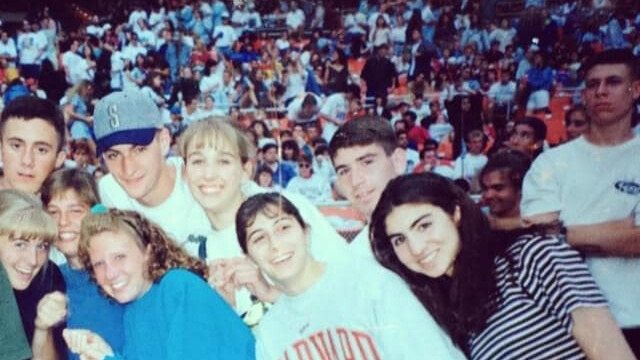As an Amazon Associate, I earn from qualifying purchases. This post may contain affiliate links.
The sitcom Seinfeld debuted in 1989, ran through 1998, and redefined the genre by focusing on minutiae instead of lessons and morals, thanks to a mantra of “no hugging, no learning” underscored by the creators. Seinfeld — the show about nothing — went on to become one of the most iconic series in television history.
I was twelve when it first aired, back when watching TV meant gathering in the family room after dinner, in front of the same set at the same time each week. During its early seasons, Seinfeld shifted between Wednesday and Thursday nights before ultimately claiming NBC’s coveted Thursday 9 p.m. slot — the heart of the network’s “Must See TV” lineup in the 1990s.
Even after all these years, the humor still lands. It’s the perfect wind-down after a day full of our own nothings.
By then, it had become a staple in our house, part of our weeknight routine. My family didn’t realize we were watching an iconic cultural moment in real-time; we just knew it made us laugh … over and over.
Today, that ritual still holds. Around 9:30 each night, my husband and I cue up Seinfeld on Netflix (for old school vibes, consider Seinfeld: The Complete Series DVD set), often watching two or three episodes as we unwind. Even after all these years, the humor still lands. It’s the perfect wind-down after a day full of our own nothings.
The Nothing That Changed Everything
When Jerry Seinfeld and Larry David pitched what became “the show about nothing,” the idea sounded almost ridiculous. A sitcom where nothing really happens? No tidy resolutions, no moral-of-the-story endings? Yet that anti-premise was exactly what made Seinfeld revolutionary.
At a time when most sitcoms revolved around family life or heartfelt takeaways — think Full House, Family Matters, or Step by Step — Seinfeld chose the opposite. It zoomed in on life’s tiniest moments: waiting for a table, losing your car in a parking garage, standing in line, or navigating an awkward conversation that goes on far too long.
It wasn’t truly about nothing, of course. It was about us: the pettiness, frustration, and absurd logic that fill the quiet spaces between big events. That’s what made it relatable then, and what still makes it funny now.
Each episode felt like someone had cracked open real life and found comedy hiding in the fine print. Watching it now, decades later, I catch myself nodding along as often as I laugh. Those tiny social absurdities (the unspoken rules, the everyday irritations) haven’t gone anywhere. If anything, they’ve just migrated from the coffee shop to the group chat.
Watch: Kramer Loses the Car | The Parking Garage
From Seinfeld Season 3, Episode 6 — “The Parking Garage”: After shopping at the mall, Jerry, George, Elaine, and Kramer can’t remember where they parked. What follows is an entire afternoon of wandering the endless concrete maze, arms full of packages and patience wearing thin. Jerry’s search turns urgent when nature calls, leading to an ill-timed bathroom improvisation … and a run-in with mall security that’s pure Seinfeld perfection.
Video via Seinfeld on YouTube.
The Cast of Quirks and Contradictions
Part of what makes Seinfeld timeless is how completely its four main characters embodied the quirks of everyday people, just turned up a notch. Jerry was the calm observer, the eye of the hurricane. Elaine was fiery, assertive, and always two seconds away from a perfectly indignant exit. George was neurotic, eternally spiraling over minor inconveniences. And Kramer? Pure chaos in human form, crashing through Jerry’s apartment door with the enthusiasm of a man who’s never experienced shame.
I’ve always gravitated toward Jerry’s dry, level sense of humor. He’s the one who seems to notice the absurdity of the world around him without getting too entangled in it. It’s a kind of observational zen that’s easy to relate to.
Just last night we rewatched Season 7, Episode 16, “The Shower Head.” Between the battle over low water pressure and the chaos of Jerry and George’s parents moving (or not moving) to Del Boca Vista, I laughed out loud more times than I could count. Somehow, it never stops being funny. Maybe because it’s all just a little too real?
Watch: The Gang Goes ‘Low-Flow’ | The Shower Head
From Seinfeld Season 7, Episode 16 — “The Shower Head”: George tries to convince his parents to move to Florida, setting off a chain of stubborn refusals and comic chaos. Meanwhile, Elaine faces an unexpected crisis when a company drug test derails her career plans, all while Jerry and Kramer wrestle with the indignities of low water pressure. Everyday problems, magnified into perfectly absurd Seinfeld proportions.
Video via Seinfeld on YouTube
The Rules That Broke the Rules
By design, Seinfeld broke all the sitcom commandments. No hugging. No learning. No tidy resolutions tied up in a moral bow. Jerry and Larry David built a universe where the characters never truly evolved, and that was the point. Real life doesn’t wrap up neatly before the credits roll.
Back in the early ’90s, that was practically TV heresy. Sitcoms were still teaching weekly lessons about friendship, family, or forgiveness. But Seinfeld treated everyday pettiness and self-interest as comedy gold instead. There was no redemption arc, no “we’ve all learned something today” moment — just the truth that people are weird, selfish, and endlessly entertaining because of it.
That “no hugging, no learning” mantra became the backbone for a new kind of television. You can see Seinfeld’s fingerprints all over later hits like The Office, Curb Your Enthusiasm, and It’s Always Sunny in Philadelphia. Each one leans into awkward realism and human imperfection. Worlds where bad behavior isn’t punished; it’s mined for laughs.
Did you know? Co-creator Larry David enforced a strict rule in the Seinfeld writers’ room: “No hugging, no learning.” He wanted to avoid the sentimental endings common in ’80s sitcoms, insisting that the characters should never grow, change, or become self-aware. That philosophy kept Seinfeld’s comedy sharp, cynical, and refreshingly true to life — a show where nothing was ever resolved, and that was exactly the joke.
What made it work, though, was the rhythm. Every episode was stitched together with snippets of Jerry’s real stand-up, giving the stories a natural beat: a setup, a punchline, and a closing callback that mirrored his act. It made Seinfeld feel different, even when it was just four people sitting in a booth arguing about etiquette and ego.
The Legacy of Language
If you measure a show’s cultural impact by the words it leaves behind, Seinfeld might be the most influential sitcom ever written. It didn’t just make people laugh — it changed how we talk about everyday life.

Think about the language Seinfeld gave us, like ‘yada yada yada,’ ‘no soup for you,’ ‘master of your domain.,’ ‘shrinkage,’ and ‘sponge-worthy.’ These weren’t just punchlines; they became new entries in the collective dictionary.
The show’s language became shorthand for regular moments we all recognize: laziness, ego, awkwardness, self-restraint, you name it. It’s even inspired merch like ‘No soup for you!” mugs and ‘Yada Yada Yada’ t-shirts, still sold today.
In our house, Seinfeld quotes still pop up constantly. Someone says “Serenity now!” when the week’s gone sideways, or calls out a “low talker” during a mumbled conversation. It’s family code at this point — a set of phrases that make sense only because we’ve shared the same laugh track for decades.
Watch: Seinfeld-isms: A Guide | Seinfeld
A Helpful Guide to the Best Catchphrases and Coined Terms from Seinfeld: This compilation rounds up some of the most memorable phrases Seinfeld introduced into everyday language. It’s a linguistic time capsule of ‘90s absurdity. From “The Contest” and “The Puffy Shirt” to “The Yada Yada” and “The Hamptons,” each moment showcases how the show turned throwaway lines into cultural shorthand. You’ll hear everything from “re-gift” to “yada yada yada,” “sponge-worthy,” “shrinkage,” and even “close talker” — proof that Seinfeld didn’t just change TV; it permanently rewired our vocabulary.
Video via Seinfeld on YouTube
Language was always part of Seinfeld’s genius. Each episode transformed mundane moments into catchphrases that still work decades later — memes before memes. It’s one of the reasons the show remains endlessly quotable, even for people who weren’t old enough to catch it on Thursday nights the first time around.
Why It Still Works
The funny thing about Seinfeld is that for a show so rooted in the ’90s — the clothes, the cordless phones, the answering machines — it never really feels dated. The details may have aged, but the observations haven’t. The awkwardness of small talk, the petty frustrations of daily life, the endless parade of social misunderstandings … all of it still feels familiar.
Watching now, the episodes land differently. As a kid, I laughed at the slapstick, like Kramer’s entrances, George’s constant meltdowns. As an adult, I laugh because I am those moments now: the overthinking, the quiet irritation, the absolute certainty that I’m right about something inconsequential.
That’s why a Seinfeld rewatch on Netflix works as comfort TV. It doesn’t try to teach, redeem, or resolve. It just mirrors the absurdity of being human and somehow makes it hilarious.
Our nightly routine has become a kind of reset button. After a long day of meetings, messages, and mental clutter, twenty minutes of Seinfeld feels like a pressure valve. Two or three episodes in, I’m reminded that the little annoyances that fill a day are the same things that can make life funny.
Seinfeld isn’t really a show about nothing. It’s a show about everything that still drives us nuts — and maybe that’s why it’s still perfect, even now, decades later, streaming from a glowing screen at the foot of the bed.







